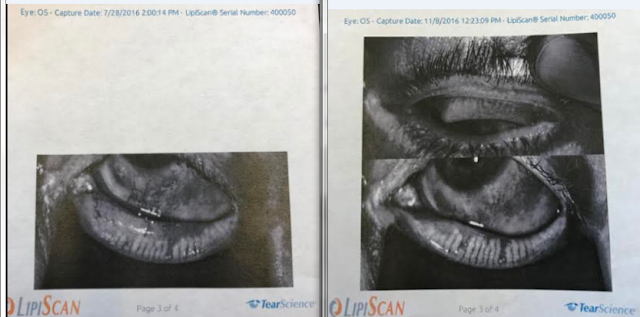IPL (Intense Pulse Light):
Before and After IPL
on LipiView/LipiScan
for Dry Eyes
Proof that IPL May Restore Meibomian Glands
The window of the eye, known as the cornea, does not have a blood supply to sustain
the corneal surface cells, known as the epithelium. Thus, each complete, stable tear is needed to
nourish and maintain the ocular surface . The human
tears and tear film consists of an amazingly complex mixture of secretions of the Lacrimal Gland, accessory
lacrimal glands, Meibomian Glands, Goblet Cells
and other endocrine systems.
the corneal surface cells, known as the epithelium. Thus, each complete, stable tear is needed to
nourish and maintain the ocular surface . The human
tears and tear film consists of an amazingly complex mixture of secretions of the Lacrimal Gland, accessory
lacrimal glands, Meibomian Glands, Goblet Cells
and other endocrine systems.
Only in the last 3-5 years has the importance of healthy Meibomian Glands been truly studied and imaged. We now realize and actually see that healthy Meibomian Glands are essential to produce a stable tear that does not evaporate too quickly. The full picture of a tear is very complex, but in this post, I will focus on the Meibomian Glands and the role of IPL.
Here below is a photo of a relatively normal row of Meibomian Glands (there are some irregularities of the glands close to the left side near the nose with some mild scar tissue). But on a scale of 0 (Normal) to 3 (severe abnormality), this patients is about a 0.3. There is a black dot in the left lower lid which is a punctal plug and thus this patients has been having symptoms of dry eyes.
Intense Pulse Light
I have written about Intense Pulse Light in a previous post.
IPL consists of a probe that is gently placed along the lower lid skin. The probe is connected to a machine that delivers brief, intense bursts of light at wavelengths between 500 and 800 nm. This intense, pulsed light increases skin temperature, destroys bad bacteria and mites along the eyelashes and meibomian glands, and decreases inflammation near the surface of the skin. This in return helps open the orifice of the meibomian glands, decreases the abnormal blood vessels that lead to inflammation and scar tissue. Combined with Meibomian Gland Expression (MGX), the Meibomian glands oil is expressed to allow the glands to produce more and more oil.
I wrote about how many of my colleagues at Harvard (and I) were very skeptical about IPL helping. Still MDs do not honestly know if Meibomian Glands can regenerate if gone or dead or destroyed or scarred together. I still cannot find anything in the literature about the regeneration of meibomian glands (“Can Meibomian Glands grow back?” patients often ask.)
Below I have my first case that shows the answer may be YES!
I was as shocked as my colleagues were when I showed them this photo. There are some issues with magnification and this is just one case, but we can clearly see more Meibum (oil) in the Meibomian Glands after 2 sessions of IPL.
Below is the a dear patient of mine who has had dry eyes for years before she came to see me for the first time. She gave me permission to show her scans.
On the left imgage is the LipiScan/LipiView of her left lower lid before IPL in July. The right image is her left lower lid AFTER IPL in November after only 2 sessions of IPL. We did not scan her left upper lid before IPL.
BEFORE IPL AFTER IPL
This is my first case of a patient who had a LipiScan/LipiView done before and after only 2 sessions of IPL. What is so surprising is that you can see the increase in Meibum in the Meibomian Glands. On the AFTER IPL scan, you can see that the meibomian glands are longer and on this AFTER IPL scan, the glands on the left side near the nose are increased in number and size. This was a shocker as we thought IPL would help prevent loss of glands, but I have not seen published data saying it restores Meibomian Glands anatomically!
Now we are doing a LipiScan/LipiView on all our patient before their IPL, LipiFlow, and Meibomian Gland Probing and 6 weeks after to see the effect.
Sandra Lora Cremers, MD, FACS



